An effective mentoring program helps individuals develop their careers and navigate the world of work. It helps transfer knowledge across generations, improves the skills of mentors and mentees, and builds practice and professional cultures.

This article offers an approach to developing and implementing a mentoring program within a practice. It is organised into six sections:
Implementing a Mentoring Program
The following sequence will help steer practices and individuals through the process of implementing a mentoring program, using the tools offered by the Champions of Change Architecture Group.
1
Research
The first step is to understand mentoring and how it relates to your practice.
Identify a champion
Nominate a champion for mentoring. Who will be responsible for its implementation and management in your practice. This will need to be someone with a good overview of your team, trustworthy with confidential and personal information.
Outlines principles and business case
Understand the general principles of mentoring and why it’s important, as well as a broad overview of the business case for mentoring.
Understand the current situation
Understand what you do now. How does mentoring work in your practice currently (even if it is it is informal)? Who has benefitted? Who hasn’t and why?
Understand staff needs and interests
Understand what your staff are looking for in mentoring. Ask them through listening and learning discussions as well as with a questionnaire – see the example below.
2
Setting goals
What does the practice hope to achieve through establishing a mentoring program? These goals should be recorded and used to interrogate the systems set up and to reflect on the success of the program when underway.
Goals should relate to the overall business plan of the practice. The mentoring strategy should be part of a larger staff development strategy including training and sponsorship.
Examples of goals include the following:
- Integrating new staff into the culture of the practice.
- Transitioning new graduates into practice.
- Assisting architects as they develop into new roles (for example project architects to team leaders).
- Graduates getting registered
- New, more diverse practice leaders.
- Rectifying skill gaps in the practice.
- Developing new skills deemed useful to the practice
Setting a budget is closely related to the goals. How much time can the practice commit to this?A more successful program should be integrated in daily work, programmed and costed. It’s is hard to prioritise mentoring particularly when time is tight. Treating the mentoring program like a project can help with this.
3
Selecting participants
This is the process of choosing participants, mentors and mentees as well as pairing them. It is important to develop processes for identifying mentors and mentees in an unbiased way, and for pairing complimentary people.
Identify mentees
On the basis of the practice goals, who do you want to participate in the program? Will it be open to everyone or a select few? If the second, how will this be handled within the practice to minimise the potential negative impact of not being selected.
Identify mentors
Do you have the right people to be mentors? Do they have the right skills and temperament to provide the support the mentees need? If not you might need to go outside your practice.
Compatibility and equity
Use the participant questionnaire to ensure that participant goals are compatible.
Review your selections from the perspective of equity. Are there biases driving your selection?
This is the process of choosing participants, mentors and mentees as well as pairing them. It is important to develop processes for identifying mentors and mentees in an unbiased way, and for pairing complimentary people.
4
Establishing protocols
Establish the rules and process that will guide the practice’s mentoring system and help assess its success.
Setting a budget
Key considerations include:
- How much can the practice commit to this process?
- Will it take place out of hours or within working hours?
- Are external resources required and what will they cost?
- How many people will participate and at what frequency?
- What financial support beyond this will the practice provide?
Setting a program
Key considerations include:
- What is the timeframe for the program?
- How does this relate to the program goals?
- How much do you want to structure the process that the mentor and mentee go through?
- Will the practice provide a script for the first meetings to guide the mentor and mentee?
Integrating external resources
Key considerations include:
- Do you need external resources?
- If so, how will they fit into the program timeframe?
- What is the lead time for these resources and these programs?
Integrating types of mentoring
Understand how different types of mentoring fit into the program. Goals should be set for each mentoring type and there should be a clear understanding of how they work together. Careful consideration of project teams and structured training can help with this.
Setting guidelines
What rules or guidelines structure the relationships of the participants? These need to be recorded for clarity and to ensure a shared vision of the process.
Document protocols
Record and map the protocols so that they are readily understood by all. This will form the basis for an equitable experience for all participants as well as the review and assessment and ongoing evolution of the program.
5
Implementation
Start the program!
6
Review and assessment
Considerations to support review and assessment include the following. (Structured proprietary mentoring programs can also provide this feedback as part of their service.)
How successful has the program been?
Has it allowed the practice goals to be met and has it done it in the best way possible? What could you do to improve the program?
Review staff development
To what extent can an individual’s development be related to the mentoring program they have participated in? Compare this growth to those that didn’t participate in the program.
Participant feedback
What did the participants think of their experience? This can be understood through questionnaires, one-on-one interviews and broader group discussions. A focused listen and learn session may be a useful way to gain this feedback.
7
Evolution
Integrate the lessons from 6 Review and Assessment and formalise these changes.
Mentoring timeline
This timeline provides an annual structure for a mentoring process; setting goals, establishing relationships and assessing success. It sets out a roadmap linking the different mentoring types throughout the year and provides flexibility for participants to refine their mentoring experience and to meet personal goals and ambitions.
Mentoring and annual appraisals should exist as separate but complementary streams that support staff on both professional and personal levels. While they are distinctly separate processes, feedback between the two should enable staff to form clearer goals in terms of personal development.
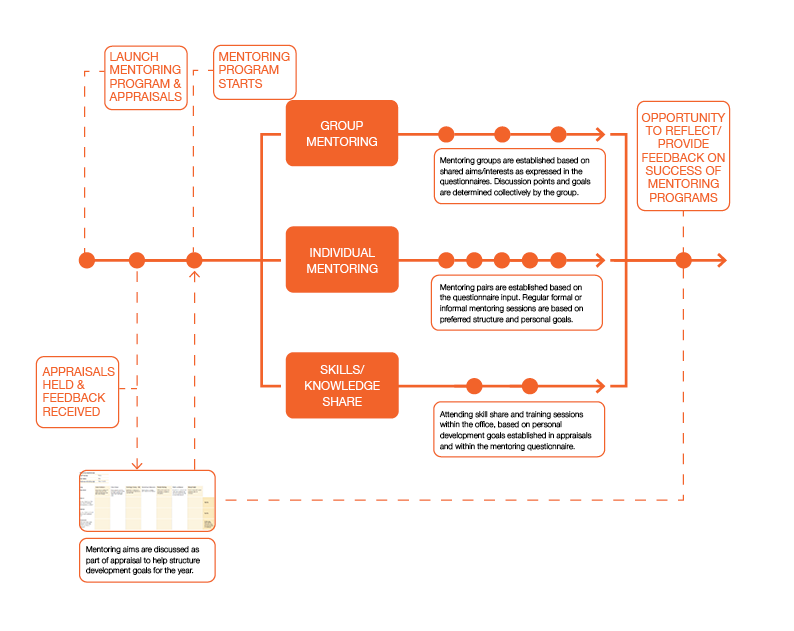
Mentoring matrix
This matrix outlines the range of mentoring types, and includes suggestions for how they might fit within a mentoring program.
A successful practice-wide mentoring strategy will take advantage of multiple mentoring types. Some elements of semi-formal or formal mentoring may be provided by groups outside the practice. Benefits include opening up a wider range of role models, influences and skills to the practice.
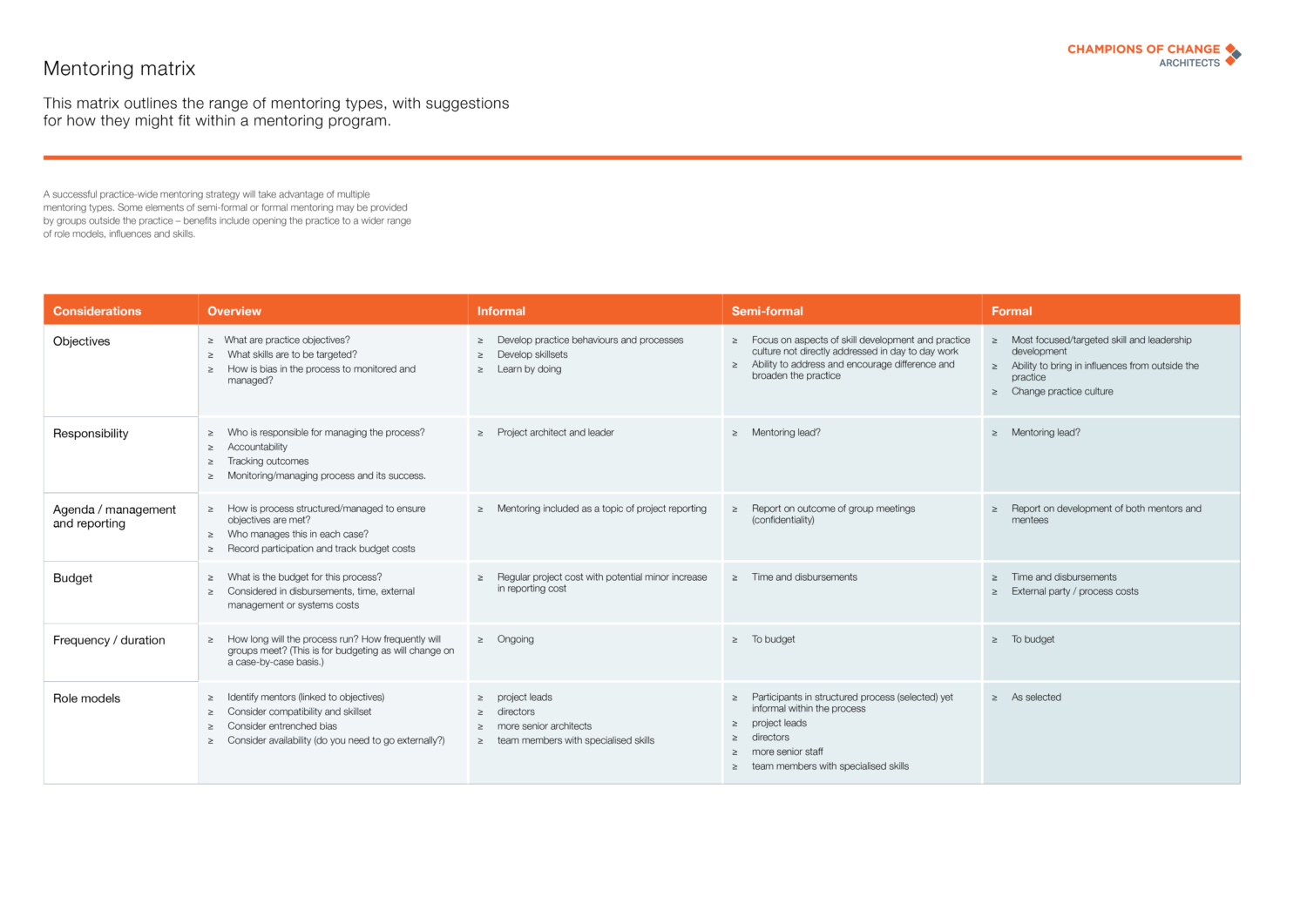
Mentoring guidelines
This matrix outlines the range of mentoring types, and roles in each.
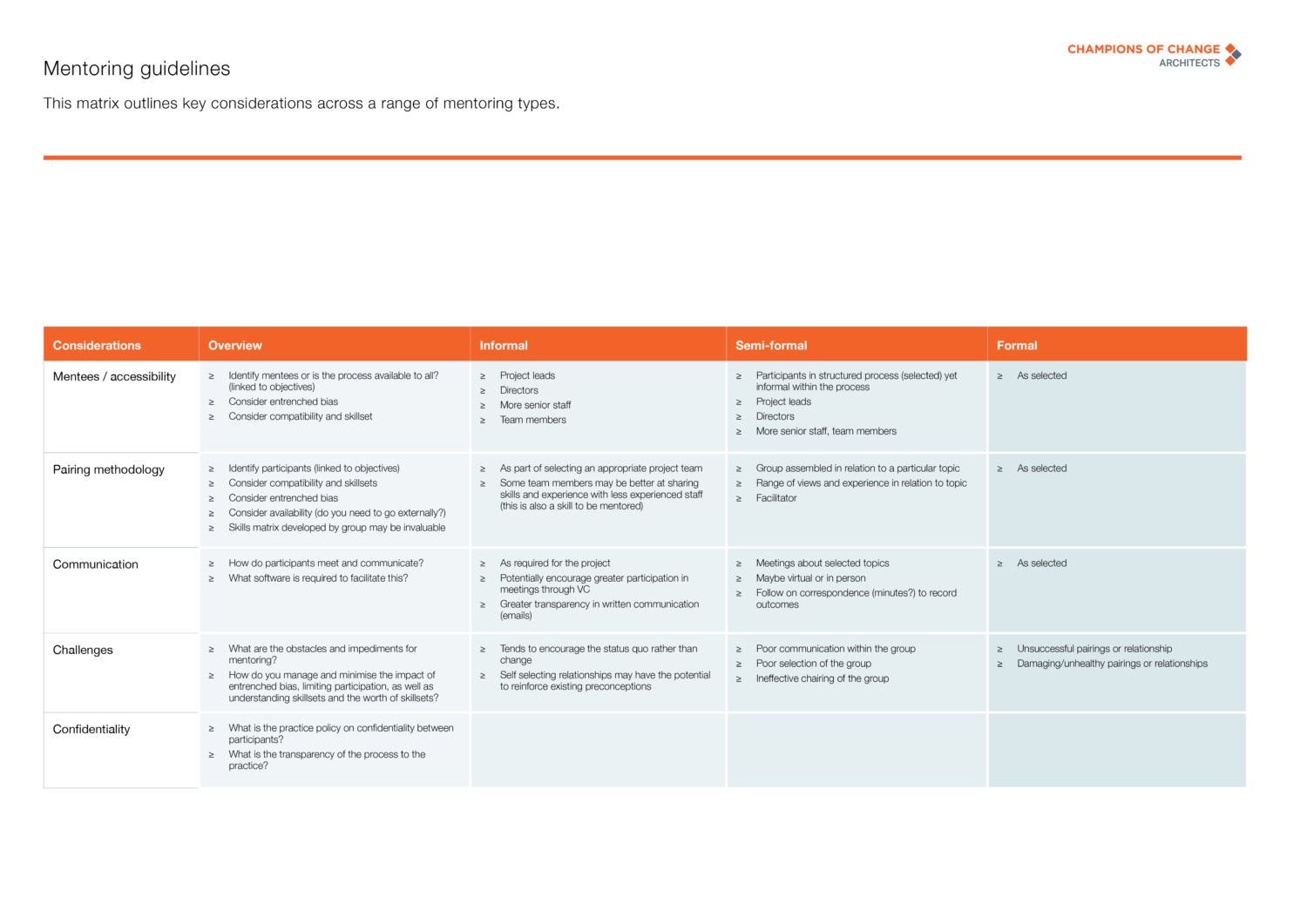
Participant questionnaire
Use a questionnaire to assist participants to understand their objectives and boundaries for their mentoring relationship. This is offered as an example of a questionnaire issued to potential participants in mentoring program to help define their objectives and compatibility. The set of topics can be tailored to suit the needs of each practice.
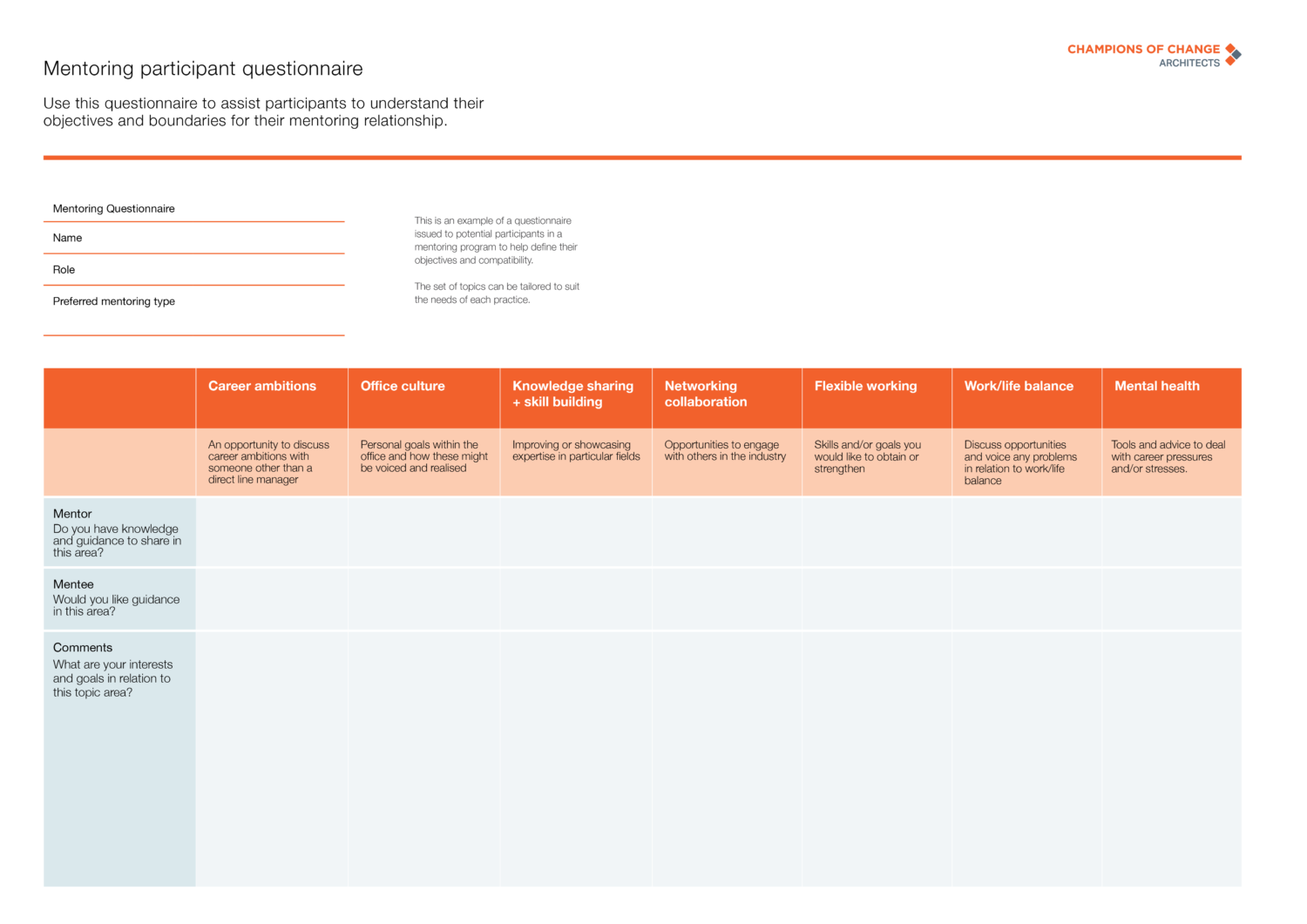
Participant guidelines
Considerations for each participant in a mentoring program – the organiser, the mentor and the mentee. The guidelines broadly describe the differing roles of the mentor and mentee. Prompts help guide each participant’s response to a range of issues.
For a mentoring relationship to be success each participant needs to have a clear understanding of what they are hoping to achieve from the process and how they want to get there. These ambitions need to be clearly discussed and made transparent to the other participant.
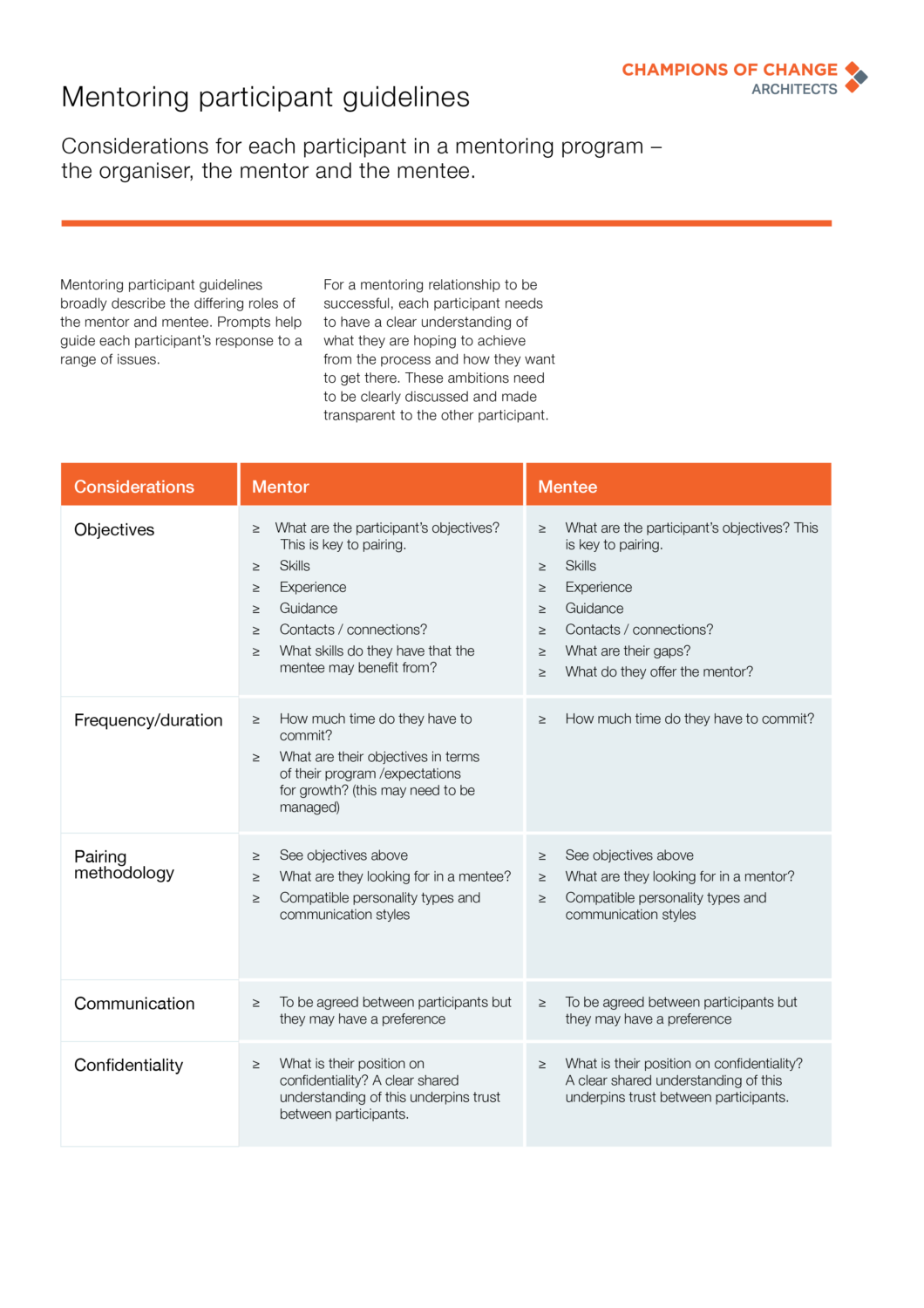
For more on Mentoring, see What is Mentoring and Why Does it Matter?, On Mentoring – Resources and the Parlour Guide to Mentoring.
This article was compiled by Justine Clark as part of a set that draws on the Mentoring Toolkit, created by the Champions of Change Architecture Group.
Contributors to the Mentoring Toolkit include Ben Green (at the time Tzannes), Thihoa Gill (Grimshaw), Eeshenn Wong (Hayball), Darryl Suttie (DesignInc), Rohan Wilson (DesignInc), Clare Barclay (DesignInc), Rebecca Champney (Nettleton Tribe), Gemma McDonald (DKO) and Raffaele Camuglia (DKO).
Stepping Up is a collaboration between Parlour, the ACA and the Champions of Change Architecture Group.




















